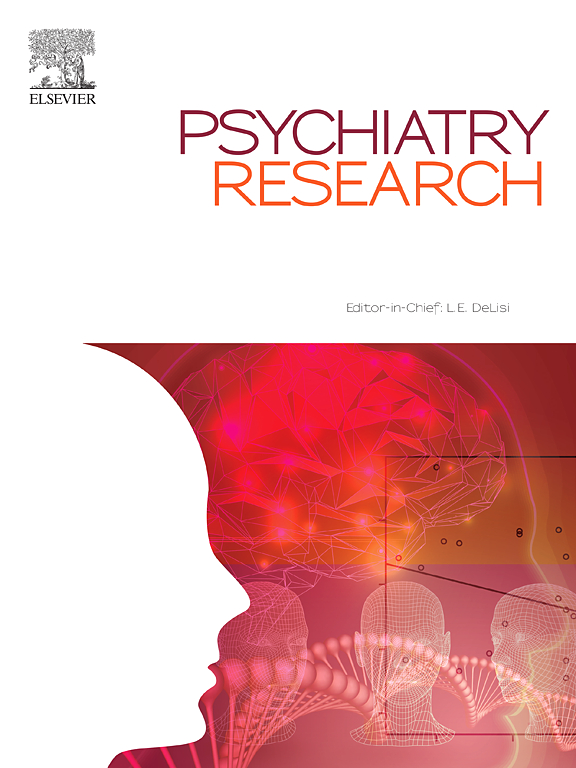Safety outcomes of ketamine for treatment-resistant depression in clinical settings and development of the ketamine side effect tool-revised (KSET-R)
IF 4.2
2区 医学
Q1 PSYCHIATRY
引用次数: 0
Abstract
Background
Ketamine and its derivates (e.g. esketamine) are increasingly used in clinical settings for treatment-resistant depression (TRD). Ketamine can give rise to acute, cumulative and longer-term side effects (SEs) across a treatment course. The Ketamine Side Effect Tool (KSET) examines adverse effects though its length has affected feasibility for use in clinical settings.
Objective
To estimate the frequency of ketamine SEs occurring in real-world settings using the KSET, additional validated scales and laboratory measures. Utilising this naturalistic data, to develop a shorter, more feasible and validated tool (KSET-Revised; KSET-R).
Methods
Retrospective patient and safety data from three outpatient services were collected which included KSET symptom questions, standardised scales and laboratory measures. We calculated frequency of SEs occurring intra-session, intersession and at follow-up. Revision of the KSET included removal of items based on a priori criteria. Construct and concurrent validity were examined by comparison of specific KSET items and the overall tolerability rating with standardised scales.
Results
Descriptive statistics including SE frequencies are reported and the KSET-R is detailed: a shorter tool with construct and concurrent validity for specific items, along with the overall tolerability rating.
Limitations
small sample size for follow-up data; predominantly subcutaneous racemic and intranasal esketamine analysed - other routes and formulations not examined; and subjective not objective cognition measured.
Conclusions
Naturalistic data gives an estimate of frequency of ketamine SEs within session, between sessions and at follow-up. The KSET-R has improved feasibility and clinical utility and is recommended for use in clinical practice where ketamine is prescribed.
氯胺酮治疗难治性抑郁症的临床安全性结局和氯胺酮副作用工具修订(KSET-R)的发展。
背景:氯胺酮及其衍生物(如艾氯胺酮)越来越多地用于临床治疗难治性抑郁症(TRD)。氯胺酮在整个治疗过程中会产生急性、累积和长期的副作用(se)。氯胺酮副作用工具(KSET)检查不良反应,尽管其长度影响了在临床环境中使用的可行性。目的:利用KSET、额外的有效量表和实验室测量来估计氯胺酮se在现实环境中发生的频率。利用这些自然数据,开发一种更短、更可行和更有效的工具(KSET-Revised;KSET-R)。方法:回顾性收集三个门诊的患者和安全性数据,包括KSET症状问题、标准化量表和实验室测量。我们计算了会话内、会话间和随访时SEs发生的频率。KSET的修订包括根据先验标准删除项目。通过比较特定的KSET项目和标准化量表的总体耐受性评分来检验结构效度和并发效度。结果:描述性统计包括SE频率的报告和详细的KSET-R:一个较短的工具,具有特定项目的结构和并发效度,以及总体耐受性评级。局限性:随访资料样本量小;主要分析皮下消旋和鼻内艾氯胺酮——其他途径和配方未检查;主观认知而非客观认知。结论:自然数据给出了治疗期间、治疗之间和随访时氯胺酮se的频率估计。KSET-R提高了可行性和临床效用,建议在开氯胺酮处方的临床实践中使用。
本文章由计算机程序翻译,如有差异,请以英文原文为准。
求助全文
约1分钟内获得全文
求助全文
来源期刊

Psychiatry Research
医学-精神病学
CiteScore
17.40
自引率
1.80%
发文量
527
审稿时长
57 days
期刊介绍:
Psychiatry Research offers swift publication of comprehensive research reports and reviews within the field of psychiatry.
The scope of the journal encompasses:
Biochemical, physiological, neuroanatomic, genetic, neurocognitive, and psychosocial determinants of psychiatric disorders.
Diagnostic assessments of psychiatric disorders.
Evaluations that pursue hypotheses about the cause or causes of psychiatric diseases.
Evaluations of pharmacologic and non-pharmacologic psychiatric treatments.
Basic neuroscience studies related to animal or neurochemical models for psychiatric disorders.
Methodological advances, such as instrumentation, clinical scales, and assays directly applicable to psychiatric research.
 求助内容:
求助内容: 应助结果提醒方式:
应助结果提醒方式:


